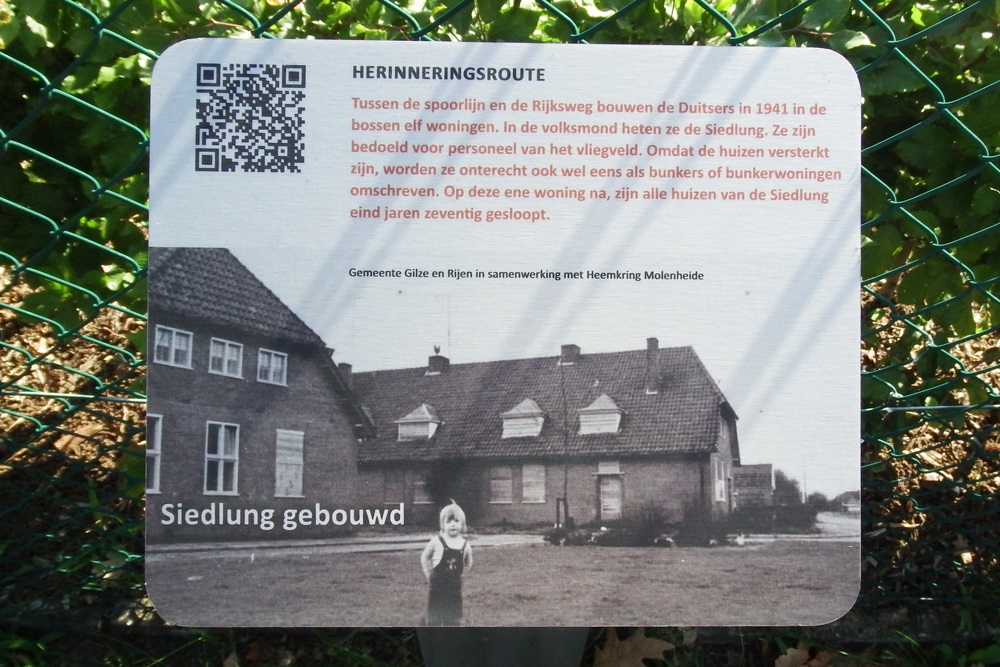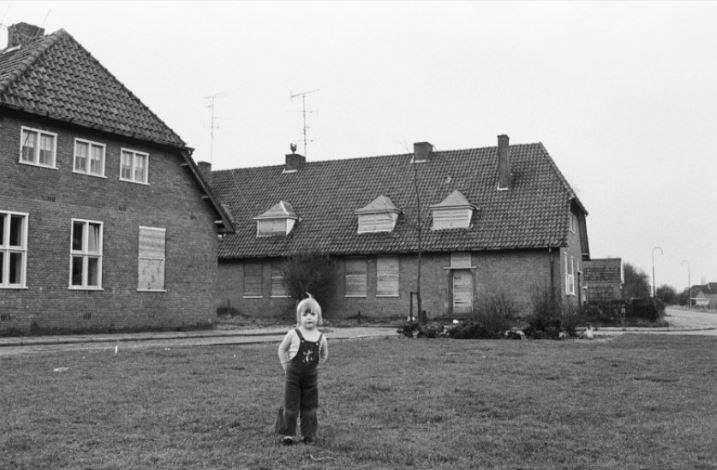Memory Route World War ll Siedlung built
In the Municipality of Gilze and Rijen is a memory route created in memory of the Second World War.
In a number of places there is a sign with a description of what happened at that place in the Second World War.
SIEDLUNG BUILT
In 1941, in the woods in Rijen, between the railway and the Rijksweg, the Germans built a residential area known as the Siedlung. In total, eleven homes were built. They were of a fortified type and were therefore sometimes (incorrectly) described as bunkers or bunker houses.
It is not entirely clear for what purpose these houses were built. In some documents just after the war, they seemed to be meant for officers, the so-called officer quarters. Other sources mentioned that they were for German civilian personnel at the airport and for the so-called Luftwaffehelferinnen. The latter women were often volunteers who employed the German Luftwaffe (Air Force) in various positions. For example, in traffic and combat management or as a nurse or secretary.
The Germans also built four large barracks near the Siedlung, near the North Brabant Leather Factory at the beginning of the current Julianastraat. These also served as accommodation for the airport staff.
But like many other buildings in the Second World War, the Siedlung homes did not survive the battle unscathed. They were all damaged; from very heavy to lighter. Immediately after the war, they became the property of the War Booty Section of the Military Authority, later referred to as the War Booty Office. Due to the acute housing shortage, many houses in the municipality were destroyed or damaged, the municipality bought the complex for NLG 12,000. The underground was partly bought, partly expropriated.
By making temporary provisions, the municipality made the homes suitable for families in Rijssen who no longer had a roof over their heads. At least some of the houses, because some were too badly damaged. But in practice, as an emergency home, they proved to be very impractical and far too large for an ordinary family. That is why the municipality split about ten houses in 1950 and renovated them. In this way, 21 new homes were created with a living room, kitchen and at least three bedrooms. The municipality then rented the houses to all kinds of residents for years.
In the early 1970s, the municipality developed the zoning plan "De Grote Spie". This is due to the population increase and the increasing need for new homes that came with it. In the vicinity of the Siedlung, the designers drew up a bungalow park, or owner-occupied homes from the more expensive segment. At that time people with a relatively low income lived in the Siedlung, which is why the city council preferred to demolish the houses. It was feared that the bungalow park still to be built would otherwise not be attractive and attract too few buyers. Moreover, the houses built during the war no longer met the requirements of the time, the municipality found. A fierce political and legal battle ensued between the municipality on the one hand and (partly) the politicians and residents on the other. In the end, the residents lost out. The rent was canceled and the residents were given several years to move. Finally, some houses were evacuated with the help of the police. While the residents were still on the street with their furniture, the houses were demolished under their eyes.
Unfortunately, there is only one building of the Siedlung left today, namely Atalanta 76-78.
Do you have more information about this location? Inform us!
Source
- Text: TracesOfWar
- Photos: Peter van Hoek (1), Heemkring Molenheide (2)
- www.heemkringmolenheide.nl
Nearby
Point of interest
- Former German Settlement Siedlung Rijen - Rijen (Gilze en Rijen)
- Former Military Area Rijen - Rijen (Gilze en Rijen)
- Memory Route World War ll Ammunition Train Station Rijen - Rijen (Gilze en Rijen)
Monument
- Memorial Killed N.S. Employee Rijen - Rijen (Gilze en Rijen)
- Liberation Route Marker 143: Gilze-Rijen airfield - Rijen (Gilze-Rijen)
- Memorial Chapel Rijen - Rijen (Gilze en Rijen)
Cemetery
- Graves Civilian Victims Catholic Cemetery Hulten - Hulten (Gilze en Rijen)
- Dutch War Grave Roman Catholic Cemetery Dorst - Dorst (Oosterhout)
- Commonwealth War Graves Roman Catholic Cemetery Gilze - Gilze (Gilze en Rijen)
Remembrance Stone
- Stumbling Stone Hoogstraat 80 - Oosterhout
- Stumbling Stone Klappeijstraat 46 - Oosterhout
- Stumbling Stone Leijsenhoek 73 - Oosterhout
Fortification
- Remnant Bunker Airport Gilze Rijen - Molenschot (Gilze en Rijen)
- Remnant Bunker Airport Gilze Rijen - Molenschot (Gilze en Rijen)
- Remnant Bunker Airport Gilze Rijen - Molenschot (Gilze en Rijen)





